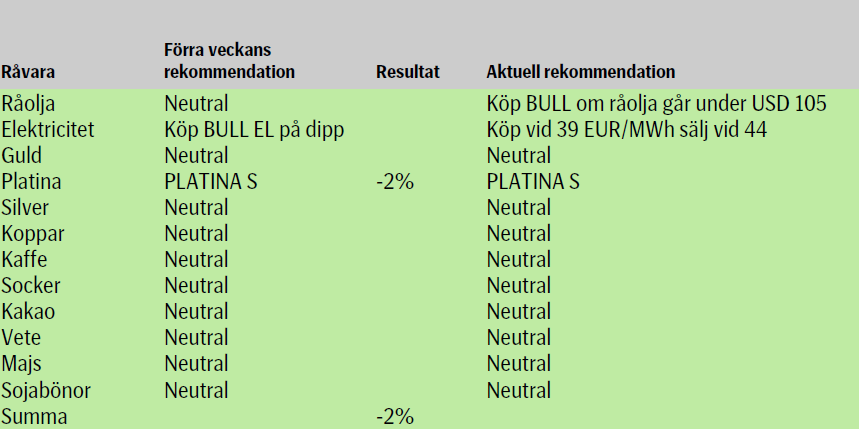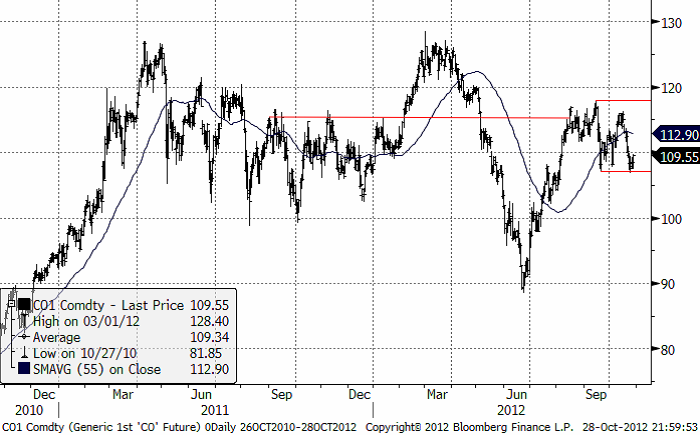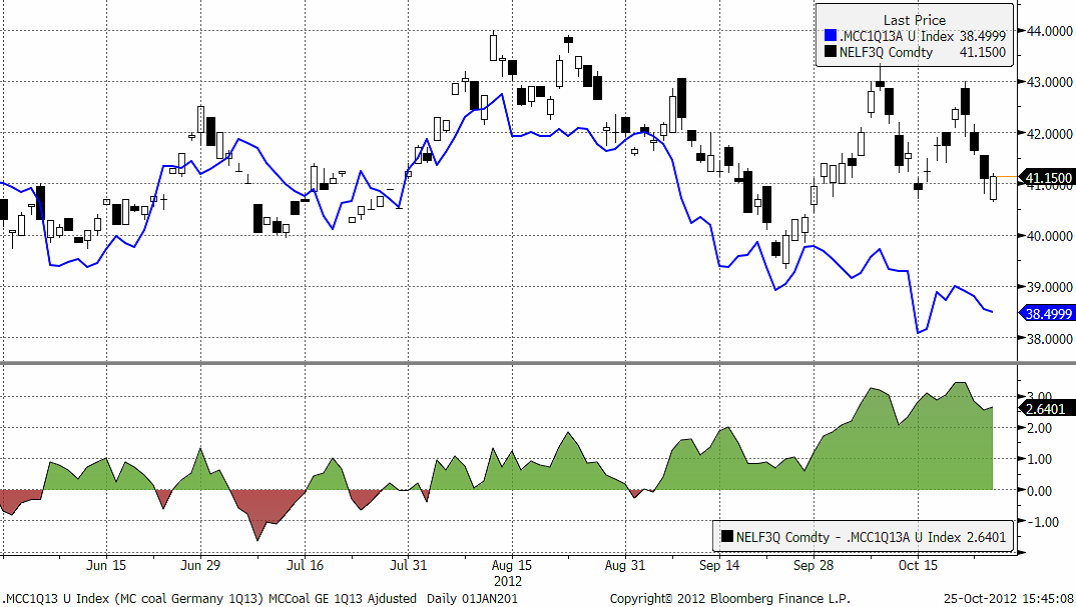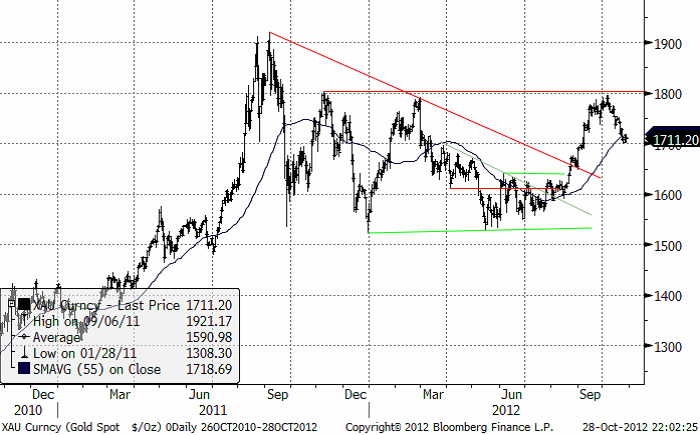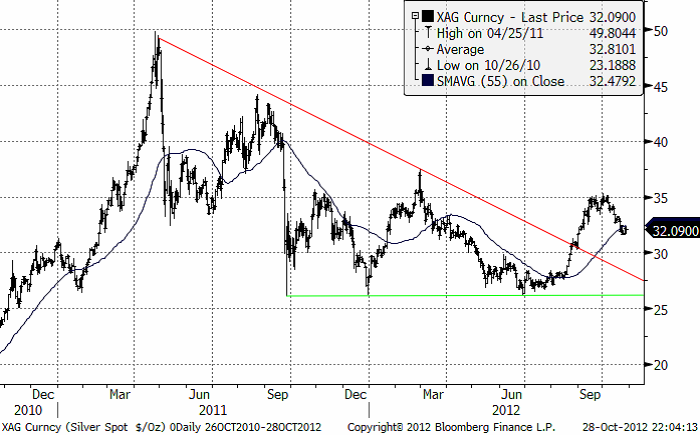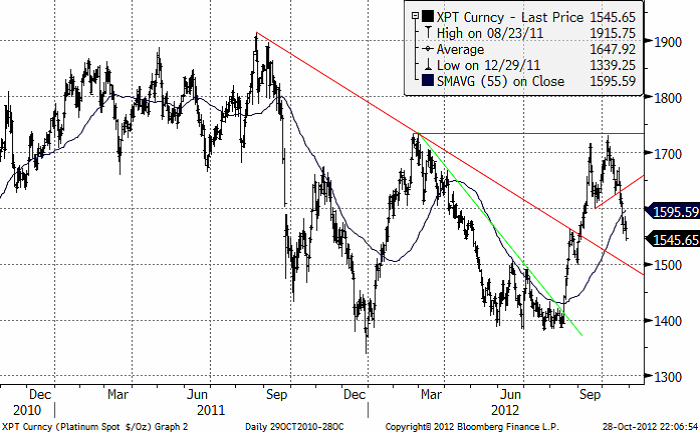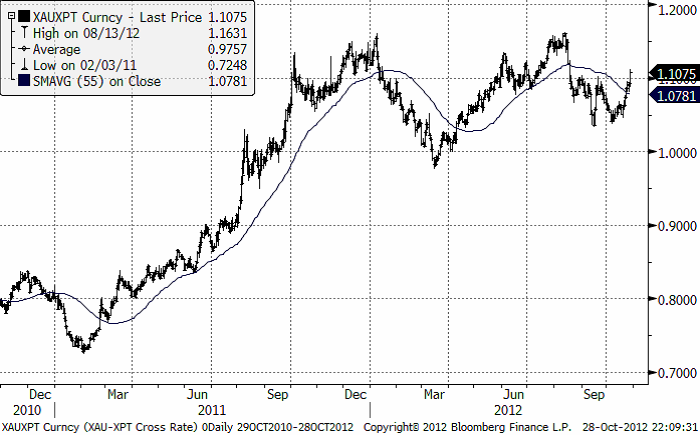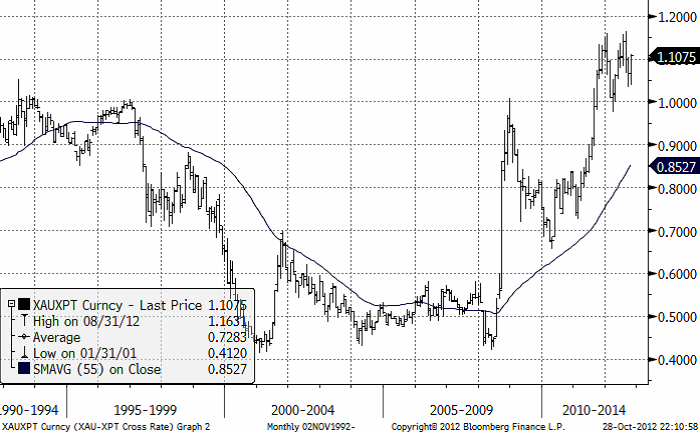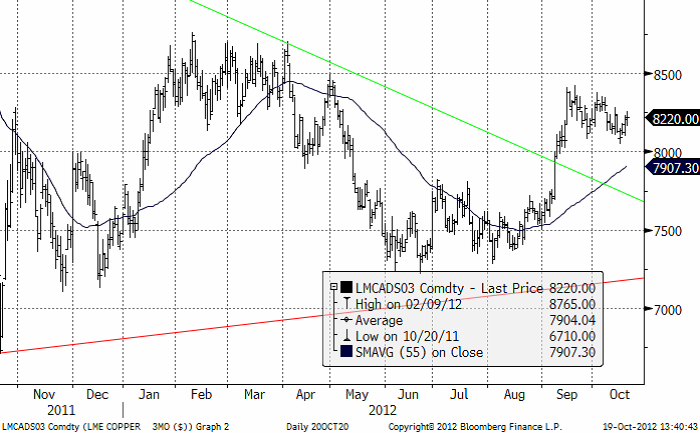Analys
SEB – Råvarukommentarer, 29 oktober 2012
Sammanfattning av rekommendationer
Råolja – Brent
Vi råder att köpa Brent-råolja vid nedgångar till under $105/fat eftersom det verkar osannolikt att priset på råolja kommer att rasa, såvida inte tillväxtprognoserna skrivs ned väsentligt. Vår uppfattning är att oljepriset kommer att fortsätta vara väl understött med tanke på stora geopolitiska risker för tillgången, strama marknader för oljeprodukter, höga incitamentpriser som krävs för att stimulera till tillräckliga investeringar, och behovet av att producentländer försvarar priser för att balansera budgetar. Vi behåller våra prognoser för genomsnittligt pris på Brent-råolja på $110/fat under Q4-12 och $105/fat under H1-13, men väljer att revidera våra uppskattningar för H2-13 och FY-14 från $115/fat till $110/fat. Prognoserna för tillgång förbättras vilket antyder en mindre stram balans på marknaden under de kommande åren, i synnerhet om tillväxten förblir matt.
Medan balansen på råoljemarknaden förblir lös är situationen för mellandestillat annorlunda. Över hela världen är förråden små. Situationen skulle verkligen kunna komma att bli väldigt stram så snart vinterns påfyllnad av bränslelagren accelererar i Europa, som förutsägbart är den stramaste marknaden med tanke på dess fordonspark av dieselbilar. En ännu svårare situation skulle kunna uppstå om temperaturerna på det norra halvklotet blir onormalt låga. Även under normala omständigheter är raffinaderier oförmögna att producera tillräckligt med mellandestillat under uppvärmningssäsongen, vilket gör förråden en nyckelfaktor vid balansering av marknaden. Den långsiktiga strukturella balansen för marknaden för mellandestillat är också oroande eftersom den leder tillväxt avseende efterfrågan. Under tiden har sannolikheten att USA släpper ut strategiska oljereserver uppenbarligen minskat i takt med att politiker inser att höga produktpriser beror på motsvarande strama marknader, och att uttömning av lager av råolja skulle vara ett ineffektivt sätt att pressa ned dem (till skillnad från deras europeiska motparter består amerikanska strategiska oljereserver nästan uteslutande av råolja).
Iran verkar vara alltmer ovilliga att återvända till förhandlingsbordet då försämringen av deras inhemska levnadsstandard fortsätter att accelerera, med potentiell baissebetonade priskonsekvenser om detta stämmer. Den stora frågan kvarstår: finns det en möjlig kompromiss som skulle kunna blidka världsopinionen samtidigt som den gör det möjligt för det iranska ledarskapet att undvika att offentligt förlora anseendet.
I kursdiagrammet ovan ser vi att 107 dollar har visat sig vara ett förhållandevis starkt stöd. 100 dollar är nästa stöd på nedsidan. Skulle 107 brytas är det inte uteslutet att marknaden vill testa 100 dollar. Det skulle i så fall vara ett köptillfälle, anser vi.
Elektricitet
Vi sänker vår föredragna utgångspunkt för haussepositioner till €39/MWh för Q1-2013-kontraktet på Nord Pool på grund av minskade marginalkostnader för kolkraftproduktion i Tyskland. Vi föredrar att handla kontraktet från haussesidan under november om denna utgångsnivå uppnås. Å andra sidan verkar €43/MWh till €44/MWh vara bra utgångspunkter för de som tar risken att handla vinterkontraktet NELFQ3 från säljsidan med BEAR EL X2 S eller med BEAR EL X4 S.
Hittills i oktober har Q1-2013-kontraktet (NELF3Q) på Nord Pool handlats för mellan €40,65/MWh och €43,35/MWh. Under den senaste veckan nådde det så högt som €43/MWh på grund av prognoser för kallare och torrare väderlek samt en studs i marginalkostnaden för kolkraftproduktion (MCCP). I skrivande stund har NELF3Q återigen fallit tillbaka på blöt väderlek och lägre marginalkostnadspriser och har faktiskt handlats på dess lägsta pris hittills i oktober. I och med att prognoser för blöt väderlek har återkommit står det totala vattenöverskottet stadigt på cirka 10 TWh mer än det normala för den här årstiden. Situationen med vattenöverskott naggar kraftkontrakten i frontmånaden i kanten och driver ned dem, samtidigt som NELF3Q-kontraktet fortsätter att upprätthålla riskpremien för vintern. Vi tror att kontraktet troligtvis kommer att bibehålla sin premie i åtminstone en månad innan ett eventuellt vattenöverskott till slut kommer att börja tära på kontraktet när tiden för leverans till snittet av de faktiska spotpriserna närmar sig. Fram till dess kommer de oundvikliga och tillfälliga torra och blöta väderperioderna att lyfta kontraktet tillbaka till nivån på €43/MWh eller högre.
Det som är oroande är att stödet från MCCP har fortsatt att försämras under oktober. Den tekniska bilden för kolpriser är direkt baissebetonad och priserna på koldioxid ser också svaga ut. Spridningen mellan NELF3Q och vårt MCCP-index (.MCC1Q13) har vidgats. Enligt vår uppfattning ökar detta nedåtrisken, vilket betyder att NELF3Q har längre väg att falla om det förlorar en del av sin riskpremie för vintern.
Vi tror fortfarande att det är tillrådligt att handla NELF3Q från haussesidan i november på grund av vintern och risken för brist på kärnkraft framöver. Vi har dock flyttat ned vår föredragna utgångsnivå från €40/MWh till €39/MW tillsammans med det lägre MCCP-indexet (.MCC1Q13). Å andra sidan verkar €43/MWh till €44/WMh vara bra utgångspunkter för de som tar risken att handla vinterkontraktet NELF3Q från säljsidan.
Guld och Silver
Kommentaren från förra veckan får stå kvar. ”Statistiken som kommer in nu är lite ”för stark” för guldet”. Veckans statistik har fortsatt på samma tema: en stadig, om än lite långsam återhämtning i USA. Frågan är dock om det räcker. centralbanken i USA, och i andra delar av världen för den delen, har tryck på sig att fortsätta med stimulanserna. Det ryktas om förestående ”paket” i Japan. Många ekonomer tror på ett amerikanskt QE4 före årsskiftet.
Nedan ser vi kursdiagrammet för guld.
Nedan ser vi kursdiagrammet för silver i dollar per troy ounce. Vi ser att 35 dollar är ett viktigt motstånd och att 30 dollar är ett viktigt stöd. En fortsatt nedgång till 30 dollar skulle vara ett bra köptillfälle. En stopp-loss-order bör då placeras strax under 30 dollar.
Platina
När både guld och basmetaller faller är det svårt för Platinametallerna att hålla emot. Proppen gick ur och vi såg ett kraftigt fall för både Platina och Palladium under veckan. Utbudsfaktorerna (kopplade till problemen i Sydafrika) hjälper inte när investerarkollektivet säljer. Londonnoteringen är ner ca 5 % i veckan till $1550/oz. Kortsiktigt finns risk för ytterligare fall. Med den tekniska analysen som vägledning bör marknaden hitta en bra stödnivå kring $1500. Kursen ligger nu just ovanför den konsolidering marknaden gjorde mellan 1500 och 1560 vid månadsskiftet augusti-september, innan marknaden bröt den nedåtgående trendlinjen. Det skulle inte förvåna om kursfallet bromsas upp, och kanske rent av vänder uppåt efter viss sidledes rörelse på de här nivåerna.
Nedan ser vi priset på guld dividerat med priset på platina. Platina har blivit billigare i förhållande till guld den senaste veckan. Vi anser att detta är ett bra argument för att sälja guld och köpa platina, allt annat lika, eller att köpa platina enbart.
Nedan ser vi kvoten mellan guld och platina för de senaste 20 åren. Vi ser att platina är exceptionellt dyrt i förhållande till guld ur ett historiskt perspektiv. Och vi bör komma ihåg att priser på råvaror på lång sikt bestäms av produktionskostnad. Medan platinagruvorna i Sydafrika inte går med vinst nu, är lönsamheten god för guldgruvorna i världen. På lång sikt talar detta för att platina är en bättre placering än vad guld är.
Koppar
Det negativa stämningsläget från LME-veckan tog överhanden för basmetallerna. Priserna har konstant fallit, inga direkta ras, men metallerna har sakta men säkert tuggat sig ner under veckan. Prisuppgången efter stimulansrundan i september är nu i de flesta fall nästa helt utraderad. Om priserna överreagerade på de kortsiktigt realekonomiska effekterna av penningstimulanserna, så känns det som en överreaktion på nedsidan nu istället. Det finns flera tecken på en makroekonomisk förbättring. Igår fredag redovisades amerikansk BNP för Q3 som kom in bättre än väntat och visar på en uppgång från 2:a kvartalet från 1,3 till 2,0 % i årstakt. Det går långsamt men åt rätt håll. Även i Kina ser det ut att bottna ur. Industriproduktionen ökar och inflationen är låg. Marknadens oro gäller inte beslutade infrastrukturinvesteringar, utan de lokala myndigheternas brist på finansiering. Ledningsbytet i Kina inger förhoppningar, men det återstår att se vad de kommer att presentera, och det kan dröja till installationen av den nya ledningen i början av nästa år. Metallimporten ökade i september, vilket är ett gott tecken (se nedan).
Koppar
Priset föll ca 2 % i veckan, från $8000 ned till ca 7800 för 3 månaders koppar på LME. De innebär att vi är tillbaka vid nivåerna i början av september. Kinas import av koppar kom in på fyramånadershögsta i september till ca 394 tton, upp från augustis 355 tton, eller ca 11 %. Under årets nio första månader har importen ökat med 32 % jämfört med förra året. Det ska inte glömmas bort att Kina har en fortsatt stor aptit på metallen. Kommentarer från Nexans, världens nästa största kabeltillverkare i veckan, noterade att substitutionseffekten mellan koppar och aluminium (koppar 4 ggr dyrare) i kablar än så länge är begränsad, och särskilt i Kina där kopparbaserad kabel är klart favoriserad. Vi föredrar att betrakta koppar som en köpvärdmetall. Kortsiktigt har vi den senaste veckan hållit oss neutrala men grundinställningen är att hitta köptillfällen.
För spannmål och övriga jordbruksprodukter hänvisas till förra veckans nyhetsbrev om Jordbruksprodukter.
[box]SEB Veckobrev Veckans råvarukommentar är producerat av SEB Merchant Banking och publiceras i samarbete och med tillstånd på Råvarumarknaden.se[/box]
Disclaimer
The information in this document has been compiled by SEB Merchant Banking, a division within Skandinaviska Enskilda Banken AB (publ) (“SEB”).
Opinions contained in this report represent the bank’s present opinion only and are subject to change without notice. All information contained in this report has been compiled in good faith from sources believed to be reliable. However, no representation or warranty, expressed or implied, is made with respect to the completeness or accuracy of its contents and the information is not to be relied upon as authoritative. Anyone considering taking actions based upon the content of this document is urged to base his or her investment decisions upon such investigations as he or she deems necessary. This document is being provided as information only, and no specific actions are being solicited as a result of it; to the extent permitted by law, no liability whatsoever is accepted for any direct or consequential loss arising from use of this document or its contents.
About SEB
SEB is a public company incorporated in Stockholm, Sweden, with limited liability. It is a participant at major Nordic and other European Regulated Markets and Multilateral Trading Facilities (as well as some non-European equivalent markets) for trading in financial instruments, such as markets operated by NASDAQ OMX, NYSE Euronext, London Stock Exchange, Deutsche Börse, Swiss Exchanges, Turquoise and Chi-X. SEB is authorized and regulated by Finansinspektionen in Sweden; it is authorized and subject to limited regulation by the Financial Services Authority for the conduct of designated investment business in the UK, and is subject to the provisions of relevant regulators in all other jurisdictions where SEB conducts operations. SEB Merchant Banking. All rights reserved.
Analys
Brent crude ticks higher on tension, but market structure stays soft

Brent crude has climbed roughly USD 1.5-2 per barrel since Friday, yet falling USD 0.3 per barrel this mornig and currently trading near USD 67.25/bbl after yesterday’s climb. While the rally reflects short-term geopolitical tension, price action has been choppy, and crude remains locked in a broader range – caught between supply-side pressure and spot resilience.

Prices have been supported by renewed Ukrainian drone strikes targeting Russian infrastructure. Over the weekend, falling debris triggered a fire at the 20mtpa Kirishi refinery, following last week’s attack on the key Primorsk terminal.
Argus estimates that these attacks have halted ish 300 kbl/d of Russian refining capacity in August and September. While the market impact is limited for now, the action signals Kyiv’s growing willingness to disrupt oil flows – supporting a soft geopolitical floor under prices.
The political environment is shifting: the EU is reportedly considering sanctions on Indian and Chinese firms facilitating Russian crude flows, while the U.S. has so far held back – despite Bessent warning that any action from Washington depends on broader European participation. Senator Graham has also publicly criticized NATO members like Slovakia and Hungary for continuing Russian oil imports.
It’s worth noting that China and India remain the two largest buyers of Russian barrels since the invasion of Ukraine. While New Delhi has been hit with 50% secondary tariffs, Beijing has been spared so far.
Still, the broader supply/demand balance leans bearish. Futures markets reflect this: Brent’s prompt spread (gauge of near-term tightness) has narrowed to the current USD 0.42/bl, down from USD 0.96/bl two months ago, pointing to weakening backwardation.
This aligns with expectations for a record surplus in 2026, largely driven by the faster-than-anticipated return of OPEC+ barrels to market. OPEC+ is gathering in Vienna this week to begin revising member production capacity estimates – setting the stage for new output baselines from 2027. The group aims to agree on how to define “maximum sustainable capacity,” with a proposal expected by year-end.
While the IEA pegs OPEC+ capacity at 47.9 million barrels per day, actual output in August was only 42.4 million barrels per day. Disagreements over data and quota fairness (especially from Iraq and Nigeria) have already delayed this process. Angola even quit the group last year after being assigned a lower target than expected. It also remains unclear whether Russia and Iraq can regain earlier output levels due to infrastructure constraints.
Also, macro remains another key driver this week. A 25bp Fed rate cut is widely expected tomorrow (Wednesday), and commodities in general could benefit a potential cut.
Summing up: Brent crude continues to drift sideways, finding near-term support from geopolitics and refining strength. But with surplus building and market structure softening, the upside may remain capped.
Analys
Volatile but going nowhere. Brent crude circles USD 66 as market weighs surplus vs risk

Brent crude is essentially flat on the week, but after a volatile ride. Prices started Monday near USD 65.5/bl, climbed steadily to a mid-week high of USD 67.8/bl on Wednesday evening, before falling sharply – losing about USD 2/bl during Thursday’s session.

Brent is currently trading around USD 65.8/bl, right back where it began. The volatility reflects the market’s ongoing struggle to balance growing surplus risks against persistent geopolitical uncertainty and resilient refined product margins. Thursday’s slide snapped a three-day rally and came largely in response to a string of bearish signals, most notably from the IEA’s updated short-term outlook.
The IEA now projects record global oversupply in 2026, reinforcing concerns flagged earlier by the U.S. EIA, which already sees inventories building this quarter. The forecast comes just days after OPEC+ confirmed it will continue returning idle barrels to the market in October – albeit at a slower pace of +137,000 bl/d. While modest, the move underscores a steady push to reclaim market share and adds to supply-side pressure into year-end.
Thursday’s price drop also followed geopolitical incidences: Israeli airstrikes reportedly targeted Hamas leadership in Doha, while Russian drones crossed into Polish airspace – events that initially sent crude higher as traders covered short positions.
Yet, sentiment remains broadly cautious. Strong refining margins and low inventories at key pricing hubs like Europe continue to support the downside. Chinese stockpiling of discounted Russian barrels and tightness in refined product markets – especially diesel – are also lending support.
On the demand side, the IEA revised up its 2025 global demand growth forecast by 60,000 bl/d to 740,000 bl/d YoY, while leaving 2026 unchanged at 698,000 bl/d. Interestingly, the agency also signaled that its next long-term report could show global oil demand rising through 2050.
Meanwhile, OPEC offered a contrasting view in its latest Monthly Oil Market Report, maintaining expectations for a supply deficit both this year and next, even as its members raise output. The group kept its demand growth estimates for 2025 and 2026 unchanged at 1.29 million bl/d and 1.38 million bl/d, respectively.
We continue to watch whether the bearish supply outlook will outweigh geopolitical risk, and if Brent can continue to find support above USD 65/bl – a level increasingly seen as a soft floor for OPEC+ policy.
Analys
Waiting for the surplus while we worry about Israel and Qatar

Brent crude makes some gains as Israel’s attack on Hamas in Qatar rattles markets. Brent crude spiked to a high of USD 67.38/b yesterday as Israel made a strike on Hamas in Qatar. But it wasn’t able to hold on to that level and only closed up 0.6% in the end at USD 66.39/b. This morning it is starting on the up with a gain of 0.9% at USD 67/b. Still rattled by Israel’s attack on Hamas in Qatar yesterday. Brent is getting some help on the margin this morning with Asian equities higher and copper gaining half a percent. But the dark cloud of surplus ahead is nonetheless hanging over the market with Brent trading two dollar lower than last Tuesday.

Geopolitical risk premiums in oil rarely lasts long unless actual supply disruption kicks in. While Israel’s attack on Hamas in Qatar is shocking, the geopolitical risk lifting crude oil yesterday and this morning is unlikely to last very long as such geopolitical risk premiums usually do not last long unless real disruption kicks in.
US API data yesterday indicated a US crude and product stock build last week of 3.1 mb. The US API last evening released partial US oil inventory data indicating that US crude stocks rose 1.3 mb and middle distillates rose 1.5 mb while gasoline rose 0.3 mb. In total a bit more than 3 mb increase. US crude and product stocks usually rise around 1 mb per week this time of year. So US commercial crude and product stock rose 2 mb over the past week adjusted for the seasonal norm. Official and complete data are due today at 16:30.
A 2 mb/week seasonally adj. US stock build implies a 1 – 1.4 mb/d global surplus if it is persistent. Assume that if the global oil market is running a surplus then some 20% to 30% of that surplus ends up in US commercial inventories. A 2 mb seasonally adjusted inventory build equals 286 kb/d. Divide by 0.2 to 0.3 and we get an implied global surplus of 950 kb/d to 1430 kb/d. A 2 mb/week seasonally adjusted build in US oil inventories is close to noise unless it is a persistent pattern every week.
US IEA STEO oil report: Robust surplus ahead and Brent averaging USD 51/b in 2026. The US EIA yesterday released its monthly STEO oil report. It projected a large and persistent surplus ahead. It estimates a global surplus of 2.2 m/d from September to December this year. A 2.4 mb/d surplus in Q1-26 and an average surplus for 2026 of 1.6 mb/d resulting in an average Brent crude oil price of USD 51/b next year. And that includes an assumption where OPEC crude oil production only averages 27.8 mb/d in 2026 versus 27.0 mb/d in 2024 and 28.6 mb/d in August.
Brent will feel the bear-pressure once US/OECD stocks starts visible build. In the meanwhile the oil market sits waiting for this projected surplus to materialize in US and OECD inventories. Once they visibly starts to build on a consistent basis, then Brent crude will likely quickly lose altitude. And unless some unforeseen supply disruption kicks in, it is bound to happen.
US IEA STEO September report. In total not much different than it was in January

US IEA STEO September report. US crude oil production contracting in 2026, but NGLs still growing. Close to zero net liquids growth in total.

-

 Nyheter4 veckor sedan
Nyheter4 veckor sedanMeta bygger ett AI-datacenter på 5 GW och 2,25 GW gaskraftverk
-

 Nyheter4 veckor sedan
Nyheter4 veckor sedanAker BP gör ett av Norges största oljefynd på ett decennium, stärker resurserna i Yggdrasilområdet
-

 Nyheter4 veckor sedan
Nyheter4 veckor sedanSommarens torka kan ge högre elpriser i höst
-

 Analys4 veckor sedan
Analys4 veckor sedanBrent edges higher as India–Russia oil trade draws U.S. ire and Powell takes the stage at Jackson Hole
-

 Nyheter3 veckor sedan
Nyheter3 veckor sedanMahvie Minerals är verksamt i guldrikt område i Finland
-

 Analys4 veckor sedan
Analys4 veckor sedanIncreasing risk that OPEC+ will unwind the last 1.65 mb/d of cuts when they meet on 7 September
-

 Nyheter3 veckor sedan
Nyheter3 veckor sedanNeil Atkinson spår att priset på olja kommer att stiga till 70 USD
-

 Analys2 veckor sedan
Analys2 veckor sedanOPEC+ in a process of retaking market share



